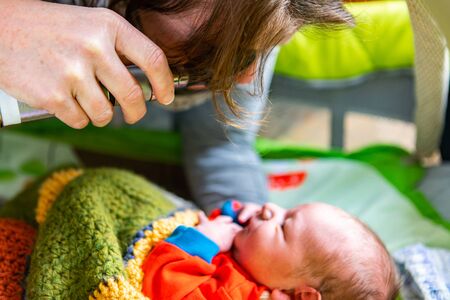Understanding Highchairs and Booster Seats
When it comes to mealtimes with little ones, British families often find themselves deciding between highchairs and booster seats. Both options are designed to make feeding easier and safer, but they each have unique features that suit different stages of your child’s development. Highchairs are typically freestanding seats with a tray, suitable for babies from around six months old—just when you might start introducing solid foods following NHS guidelines. Popular brands like Stokke Tripp Trapp or IKEA’s ANTILOP highchair are common sights in UK homes and cafés. These chairs provide a secure, elevated space where your baby can join the family at the table, offering support for their posture and safety harnesses to keep wriggly little ones secure.
Booster seats, on the other hand, are designed for slightly older toddlers—often from 18 months upwards—who can sit up independently but still need a bit of elevation to reach the dining table comfortably. Booster seats, such as the Mamas & Papas Baby Bud or the portable Tomy Booster Seat, attach securely to standard dining chairs and usually come with straps for extra safety. They’re ideal for families who want flexibility: whether you’re heading out to a local pub for Sunday lunch or visiting grandparents, booster seats are easy to pack up and take along.
| Highchair | Booster Seat | |
|---|---|---|
| Recommended Age Range | 6 months – 3 years | 18 months – 5 years |
| Typical Features | Freestanding, tray included, harness, adjustable height/recline | Attaches to regular chair, compact, portable, straps for safety |
| Popular UK Examples | IKEA ANTILOP, Stokke Tripp Trapp | Mamas & Papas Baby Bud, Tomy Booster Seat |
This distinction helps British parents choose what’s best for their family dynamic—whether you need a sturdy base for first tastes of mushy peas or a travel-friendly seat for holiday outings.
Safety Standards and Regulations in the UK
When choosing between highchairs and booster seats, British families must prioritise safety above all else. The UK has clear safety standards and recommendations to help parents make informed decisions. Both highchairs and booster seats are regulated under strict guidelines to ensure children’s wellbeing at home and when dining out.
British Standards for Children’s Seating
Products sold in the UK must comply with specific British Standards (BS) that address stability, durability, and restraint systems for children’s furniture. For highchairs, BS EN 14988 is the main standard, covering requirements such as tip-over resistance, secure harnesses, and safe construction materials. Booster seats typically adhere to BS EN 16120, focusing on similar aspects but designed for use on standard chairs. These standards ensure any product bearing a CE mark or British Standard Kitemark has passed rigorous testing.
NHS and RoSPA Recommendations
The NHS advises parents to always use the safety harness provided with both highchairs and booster seats to prevent falls. They also recommend placing seating on flat, stable surfaces away from hazards like hot drinks or cords. Meanwhile, the Royal Society for the Prevention of Accidents (RoSPA) highlights the importance of following manufacturer instructions during assembly and everyday use. Both organisations urge families to supervise children closely whenever they are seated.
Comparison of Key Safety Features
| Highchairs | Booster Seats | |
|---|---|---|
| Relevant British Standard | BS EN 14988 | BS EN 16120 |
| Mandatory Harness? | Yes (5-point recommended) | Yes (3 or 5-point options) |
| Stability Tests | Required | Required (when attached to adult chair) |
| NHS Guidance Compliance | Harness & stability focus | Harness & correct attachment focus |
The Bottom Line for British Parents
No matter which option you choose, look for products that meet UK safety standards and follow NHS and RoSPA guidance. Always register new purchases with the manufacturer to receive product recalls or updates, ensuring your child’s mealtime experience is both enjoyable and secure.

3. Practical Considerations for British Homes
When deciding between highchairs and booster seats, it’s essential to consider how each fits within the unique context of British homes. Many families in the UK live in cosy terraces, semi-detached houses, or modern flats, where space can be at a premium. Let’s explore some practical points that may help guide your choice.
Space-Saving Solutions
British homes often have compact kitchens and dining rooms, especially in older Victorian or Edwardian properties. Highchairs can take up a significant footprint, while booster seats offer a more streamlined alternative that attaches directly to existing dining chairs and can often be stored away when not in use. This flexibility is invaluable for families wanting to maximise their living space.
Comparison Table: Space & Storage Needs
| Highchair | Booster Seat | |
|---|---|---|
| Footprint Size | Larger; stands alone | Minimal; attaches to chair |
| Storage | May require dedicated space | Easily stored or portable |
| Flexibility | Fixed position | Can be moved room-to-room or taken out |
Traditional Dining Set-Ups in the UK
Family mealtimes are an important part of British culture, with many gathering around dining tables for Sunday roasts or weekday suppers. Highchairs often come with their own tray, which can separate little ones from the family table. In contrast, booster seats encourage children to sit right up at the table alongside everyone else, fostering inclusion and shared mealtime rituals—a key aspect of psychological and social development.
How Each Option Fits Into Everyday Life
The adaptability of booster seats makes them particularly suitable for families who entertain guests or travel frequently, as they can be easily packed and used in different settings—whether at grandma’s house or a local pub. Highchairs, meanwhile, tend to offer more support for younger babies but are less versatile once your child grows and wants to join in family activities at the main table.
Summary
Ultimately, your choice may come down to balancing tradition with practicality. If your home is spacious and you value a dedicated feeding space, a highchair may fit well. For those seeking a flexible, space-saving option that promotes togetherness at the table—hallmarks of many British households—a booster seat could be ideal.
Dining Out and Family Gatherings: British Lifestyle Factors
When it comes to mealtimes away from home, British families often find themselves navigating the unique settings of local pubs, bustling high street cafés, and traditional family gatherings. The choice between a highchair and a booster seat can greatly impact these outings, making portability, suitability for UK establishments, and user-friendliness essential considerations.
Portability on the Go
For parents constantly on the move—whether popping into a village tearoom or attending Sunday roast at Granny’s—the weight and foldability of your child’s seat matter. Highchairs, especially traditional wooden ones commonly seen in British homes, tend to be bulkier and less convenient to transport. Booster seats, particularly modern designs with carry handles or straps, are often lightweight and compact, fitting easily into car boots or even under prams.
Suitability for UK Restaurants and Pubs
The typical UK eatery may not always have ample space for large highchairs, nor guarantee that one will be available during busy hours. Many British pubs and restaurants do provide their own highchairs, but cleanliness and condition can vary. Booster seats, which attach securely to most standard dining chairs, offer a practical solution—allowing your child to join in comfortably at any table without relying on venue-provided equipment.
Quick Comparison: Dining Out Essentials
| Highchair | Booster Seat | |
|---|---|---|
| Portability | Bulky; often requires car transport | Lightweight; easy to carry or pack |
| Fits in Pubs/Restaurants | May be too large for small spaces | Attaches to most standard chairs |
| Ease of Cleaning | Larger surfaces; trickier to wipe down on the go | Simpler design; easier quick clean-up |
| Adaptability During Visits | Less flexible; best for long stays | Ideal for short visits or moving venues |
The Social Side of Mealtimes
British family life thrives on togetherness—whether at a fish and chip supper by the seaside or around the table at a relative’s house. A booster seat’s adaptability supports this sociable spirit, allowing your child to participate fully wherever you go. Highchairs are still valued for longer stays or when stability is needed (such as with younger babies), but boosters offer unmatched flexibility for the spontaneous outings so common in UK family culture.
5. Parent-Child Interaction and Developmental Impact
When considering whether to choose a highchair or a booster seat, it’s essential for British families to reflect on how each option shapes daily parent-child interactions and supports developmental milestones. Shared mealtimes are at the heart of many UK households, fostering not only nourishment but also emotional bonds and social learning.
Bonding at Mealtime
Highchairs often provide a dedicated, secure space for babies, allowing parents to focus solely on their child during feeding. This environment can encourage more direct eye contact and verbal communication, both vital for emotional attachment. In contrast, booster seats bring children closer to the family table earlier, promoting inclusivity and allowing little ones to observe and mimic social behaviours common in British dining culture—such as passing food or joining in conversation.
Supporting Social and Motor Development
The choice of seating can influence a child’s developing skills:
| Highchairs | Booster Seats | |
|---|---|---|
| Social Skills | Facilitates one-on-one interaction with caregiver; ideal for focused early feeding routines. | Promotes group inclusion; encourages participation in family traditions like Sunday roast. |
| Motor Skills | Stable platform for practising self-feeding; supportive posture aids hand-to-mouth coordination. | Requires more balance and independence; strengthens core muscles as child sits at table height. |
| Feeding Development | Controlled environment minimises distractions; good for introducing solids or new textures. | Exposure to varied foods and utensils as part of shared meals; opportunity to copy siblings or adults. |
Cultural Context: The British Family Table
In many British homes, the dinner table is where stories are shared and manners are learnt. Highchairs may suit younger babies needing extra support, while booster seats naturally integrate toddlers into this cherished setting sooner. Both options play unique roles in helping children develop confidence, independence, and a sense of belonging within the family dynamic.
Environmental, Budget, and Sustainability Considerations
When British families weigh up the choice between highchairs and booster seats, it’s not just about immediate practicality or safety—many are also thinking long-term about the environment, their family budget, and broader sustainability trends. In recent years, UK parents have shown a growing preference for products that are eco-friendly, built to last, and offer good value for money over time. Below is a helpful comparison of factors to consider:
| Consideration | Highchair | Booster Seat |
|---|---|---|
| Resale Value | Sturdy wooden or designer brands often fetch higher resale prices on platforms like Facebook Marketplace or local NCT sales | Generally lower resale value but easy to pass on to friends or donate due to compact size |
| Quality & Longevity | Premium models can be used for several children and may convert into toddler chairs, extending usability | Usually suited for a shorter period but some adaptable designs grow with your child |
| Sustainability | Wooden highchairs made from sustainable sources are increasingly popular; look for FSC certification | Many booster seats use recycled plastics; lightweight options reduce material usage and transport emissions |
| Budget Impact | Higher initial outlay but potential long-term savings if used across siblings or resold | Lower upfront cost, ideal for families watching their spending or with limited space |
Eco-conscious British parents often opt for products that align with their values. Wooden highchairs sourced from responsible forestry are particularly sought-after in the UK, while plastic booster seats made from recycled materials are gaining traction among those prioritising sustainability. Considering the strong culture of hand-me-downs and reselling within British communities, it’s wise to invest in quality items with proven durability. Ultimately, reflect on your family’s priorities—whether that’s minimising environmental impact, stretching your budget further, or choosing versatile products that stand the test of time.


